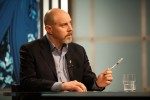Deacon-structing: Electing a Pope
Deacon Pedro
Monday, May 5, 2025

Domenico Ghirlandaio, "Calling of the First Apostles." Sistine Chapel collection.Wikimedia Commons.
According to VARIETY MAGAZINE, the viewership for the film CONCLAVE spiked 283% on April 21, as news of Pope Francis’ death made the news around the world. While the film captures a bit of the sense of mystery surrounding the election of a pope, the real event is far different. There are no secret plots, manipulations, or dramatic showdowns in the Sistine Chapel. Instead, the actual conclave is a deeply spiritual, prayerful, and highly structured process, guided by centuries of tradition and the quiet work of the Holy Spirit. For Catholics, it’s one of the most sacred moments in the life of the Church: the moment when the successor of St. Peter is chosen to shepherd the People of God.
 In "Deacon-structing," Deacon Pedro takes a particular topic apart, not so much to explore or explain the subject to its fullness, but rather to provide insights that will deepen our understanding of the subject. And don’t worry, at the end of the day he always puts the pieces back together. There are no limits to deaconstructing: Write to him and ask any questions about the faith or Church teaching: pedro@saltandlighttv.org
In "Deacon-structing," Deacon Pedro takes a particular topic apart, not so much to explore or explain the subject to its fullness, but rather to provide insights that will deepen our understanding of the subject. And don’t worry, at the end of the day he always puts the pieces back together. There are no limits to deaconstructing: Write to him and ask any questions about the faith or Church teaching: pedro@saltandlighttv.org
Why the Pope Matters
The Pope is not just the bishop of Rome. He is the successor of St. Peter, entrusted with the care of the universal Church. He is not the successor of Christ, nor his substitute, but the Vicar or representative of Christ on earth. Catholics around the world look to the Pope for teaching, unity, and leadership. Because of this, the Church takes great care to ensure that choosing a new Pope is done prayerfully, thoughtfully, and free from outside pressure. In our Q and A, we described some of the reforms that were made over the centuries to ensure that prayerful and independent process. Now I’ll go a bit deeper on some parts of that process.What Happens in a Modern Conclave?
Today, the rules of papal elections are outlined in Universi Dominici Gregis, issued by St. John Paul II in 1996 and modified slightly by Benedict XVI and Francis. Here are some more aspects about the Conclave:- Prayer: Perhaps this is the most important aspect (and the one left out of most films). A Conclave is first and foremost a prayerful event. The first thing the Cardinals do is gather in St. Peter’s Basilica to celebrate the Mass Pro Eligendo Romano Pontifice (“for the election of the Roman Pontiff”). The Mass is presided over by the Dean of the College of Cardinals. After the Mass, when the Cardinals are ready to enter the Sistine Chapel, they will first enter the Pauline Chapel (down the Hall from the Sistine) to ask for the help of the Holy Spirit. They will hear a brief exhortation from a preacher. From there, while singing the Litany of the Saints, they enter the Sistine Chapel.
- Eligibility: Only cardinals under the age of 80 may vote. In 1975, Pope Paul VI established the maximum number of Cardinal-electors at 120. Pope John Paul II and Benedict XVI, while reiterating this number, both had more than 120 cardinal electors, reaching as high as 135 in 2001 and 2003. Pope Francis has exceeded the limit in all of his 10 consistories, reaching as high as 140 in December 2024. In the General Congregations last week, the College declared that when Pope Francis did so, he "dispensed with this legislative provision" limiting the electors to 120. Currently, all 133 Cardinal-electors are eligible to vote.
- Living arrangements: The cardinals reside in the Casa Santa Marta, a Vatican guesthouse during the conclave. If the name sounds familiar, it’s because Pope Francis made it his residence. However, the voting takes place in the Sistine Chapel, under Michelangelo’s famous fresco of the Last Judgment — a powerful reminder of the weight of their decision.
Where Is the Holy Spirit in All This?
Many Catholics wonder: does the Holy Spirit explicitly dictate who will be the new pope? Cardinal Joseph Ratzinger, who later became Pope Benedict XVI, offered a thoughtful answer:I would not say so, in the sense that the Holy Spirit picks out the Pope... I would say that the Spirit does not exactly take control of the affair, but rather like a good educator, as it were, leaves us much space, much freedom, without entirely abandoning us. Thus the Spirit’s role should be understood in a much more elastic sense, not that he dictates the candidate for whom one must vote. Probably the only assurance he offers is that the thing cannot be totally ruined.With characteristic humility, he added: "There are too many contrary instances of Popes the Holy Spirit obviously would not have picked!” In other words, while the Holy Spirit is present, inspiring, and guiding, He respects human freedom. The process is not magic — it’s discernment. The cardinals bring their prayer, wisdom, and personal experiences into the decision, trusting that God works through even imperfect people and systems.
Interesting Facts You Might Not Know
- They burn the ballots using a special stove inside the Sistine Chapel, installed with a chimney visible from St. Peter’s Square.
- The shortest conclave in modern history lasted just a day (Pope Pius XII in 1939).
- The longest? Nearly three years, from 1268–1271.
 In "Deacon-structing," Deacon Pedro takes a particular topic apart, not so much to explore or explain the subject to its fullness, but rather to provide insights that will deepen our understanding of the subject. And don’t worry, at the end of the day he always puts the pieces back together. There are no limits to deaconstructing: Write to him and ask any questions about the faith or Church teaching: pedro@saltandlighttv.org
In "Deacon-structing," Deacon Pedro takes a particular topic apart, not so much to explore or explain the subject to its fullness, but rather to provide insights that will deepen our understanding of the subject. And don’t worry, at the end of the day he always puts the pieces back together. There are no limits to deaconstructing: Write to him and ask any questions about the faith or Church teaching: pedro@saltandlighttv.orgRelated Articles:
>>
SUPPORT LABEL
$50
$100
$150
$250
OTHER AMOUNT
DONATE
Receive our newsletters
Stay Connected
Receive our newsletters

Stay Connected












